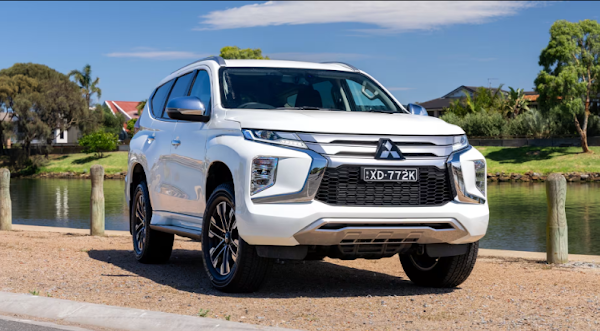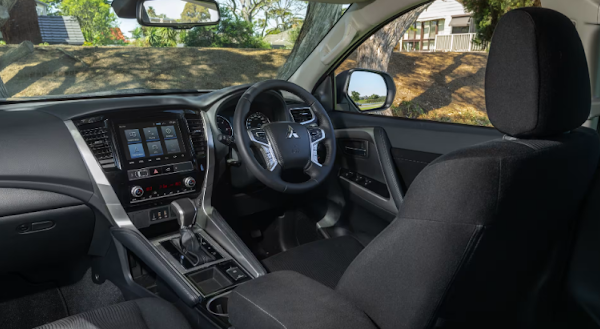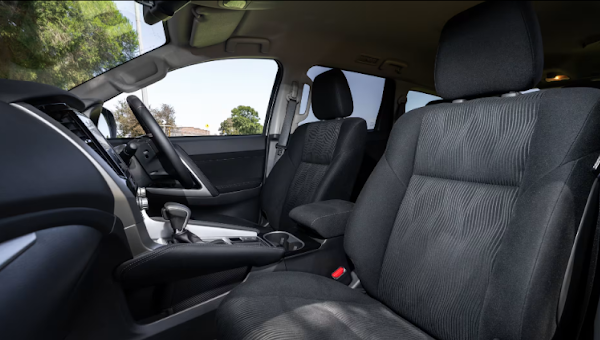
The Mitsubishi Pajero Sport is a low-cost way to get into the rugged seven-seat family SUV market with comprehensive features and plenty of space. But it's starting to feel its age, and that pricing isn't as irresistibly sharp as it once appeared.
2024 Mitsubishi Pajero Sport GLS
The Mitsubishi Pajero Sport may seem like a relatively new option in the large SUV market with less than a decade in the Australian market. However, the model's bloodline actually started with the Challenger, which has been popular with local customers since the mid-1990s.
This current model was introduced in 2015, but was updated with a facelift and some tech enhancements in the middle of 2023. Its new 'dynamic shield' styling brought its looks into line with the rest of the family, while a few upgraded features were also introduced, but it's essentially the same Pajero Sport underneath that arrived nearly 10 years ago.
You can still have a very affordable entry GLX or the more premium Exceed and GSR, but here we're focusing on the middle-of-the-range GLS, which in many model lines often represents the value pick of a line-up.
How much is a Mitsubishi Pajero Sport?
The Mitsubishi Pajero Sport range opens with the bargain-basement GLX for $44,940, but it sacrifices significant kit to come in under $45K, including the third row of seating and four-wheel drive.
To hop into a more serious Pajero Sport costs $49,940, which gets the same level of specification but with seven seats and four-wheel drive. At the top of the pack the Exceed offers a flagship fit-out for $60,690, or the black-pack themed GSR will set you back $62,440 – all before on-road costs.
In the middle of the pack, however, the GLS is available with seven seats and rear-wheel drive for $50,190 (as tested here) or the four-wheel-drive GLS for $55,190, both prices not including on-road costs. On paper, either version would appear to offer a good balance of equipment and practicality without investing extra cash in some of the more aspirational trimmings if the budget is tight.
There's no shortage of options in the large SUV market, but the pickings become slimmer when you refine the offerings down to proper four-wheel-drives with seven seats. But if you don't necessarily need that go-anywhere capability, saving $5000 might make the rear-drive version quite attractive.
While the Pajero Sport used to be one of the most affordable, it's now being challenged for price and specification by some mainstream rivals.
For about the same cash, Ford's Everest can be had in the entry-level Ambiente in rear-wheel drive ($53,990 +ORCs), Isuzu's mid-range MU-X is slightly higher-priced ($55,900 +ORCs) in the LS-U 4x2 , while Toyota's 4x4-only Fortuner is available from $53,775 +ORCs for the entry-level GX.
If price is paramount, there are also a couple of lower-priced options from challenger brands such as the GWM Tank 300, LDV D90, SsangYong Rexton or Mahindra Scorpio.
Key details 2024 Mitsubishi Pajero Sport GLS 7-seat 2WD
Price $50,190 plus on-road costs
Color of test car White
Options Tow bar kit – $1495
Electric brake controller – $689
Carpet mats – $236
Price as tested $52,610 plus on-road costs
Isuzu MU-X Rivals | Toyota Fortuner | Ford Everest

How big is a Mitsubishi Pajero Sport?
Space is something the Pajero Sport offers in abundance. While its relatively chunky drivetrain robs a little around the footwells and center console at floor level, the cabin is spacious and light.
There's lots of space for occupants in both the front and second rows, with plenty of room in the rafters for taller passengers. Head room in the front row is up to 1022mm, while it's still generous in the second row measuring 957mm but getting a little tight in the back with 917mm.
The door pockets are a little skinnier than some rivals, and the storage cubby ahead of the gear shifter could be a bit more accommodating. But there's a very useful and versatile space below the console, along with two useable cupholders and a decent central storage bin toward the back.
Mitsubishi is refreshingly honest and descriptive with its claimed boot and load area volume.
You can have up to a 673-litre boot if the five-seat is chosen, but as this is the seven-seater its boot shrinks to 502L, which is on the small side for a large SUV. With the third row of seating in place there's still 131L of space left, which is about average.
Volume with the second row stocked is, again, about average at 1488L. With the maximum load bay freed up, items measuring up to 1575mm in length can be accommodated and there's up to 1370mm of width to play with, or 1000mm if loading between the wheel arch intrusions.
Those storage capacities are worthy of merit given the Pajero Sport's exterior, and while large, it is not the biggest in class with an overall length of 4825mm and a width that measures 1815mm. Height comes in at 1835mm.
Having the third row as a seating option is handy, but commissioning the rearmost seats is not the smoothest process, while stowing is a bit fiddly too. In addition, there's a relatively small gap for entry and exit between the second-row seats and door aperture, which makes the process of loading a full car of people a bit tricky.
Standard comfort and convenience equipment is well represented with two USB sockets and a 12-volt power socket in the second row. There's another 12-volt socket in the boot and one for the front row as well, along with a 220-volt powerpoint.
About the cabin you'll find six cupholders, four bottle holders, a decent center storage bin with tray in front, keyless entry and start button, reasonable quality fabric upholstery, leather for the steering wheel, and backrest adjustment for second and third row seating but no slide adjustment. The latter is a notable omission.
As it's the GLS, the tailgate is power-operated, there's privacy glass for the rear windows, while the second-row occupants are offered their own climate-zone controls.
2024 Mitsubishi Pajero Sport GLS 7-seat 2WD
Seats Seven
Boot volume 131L to third row
502L to second row
1488L to first row
Length 4825mm
Width 1815mm
Height 1835mm
Wheelbase 2800mm

Does the Mitsubishi Pajero Sport have Apple CarPlay and Android Auto?
While the Pajero Sport offers a good level of technology for the price, most of it starts to feel a little dated. The 8.0-inch central touchscreen is relatively small by today's standards, and there's no digital driver's instrument cluster to complement it unless you go for the Exceed or GSR.
And while there is a small color screen between conventional gauges, there is no option for a digital speedometer reading among its display content.
Thankfully, Android Auto and Apple CarPlay are both supported in all grades, which partly redeems the aging graphics. If you don't want to plug in a device, the GLS has its own navigation. Wireless connection is not supported.
Nice chunky climate-control dials and buttons are appreciated over HVAC functions buried in virtual menus, even if the display looks a little 1990s digital.
Only the Exceed and GSR grades of Pajero Sport get the option to use Mitsubishi's Remote Control Smartphone App, which allows the user to operate the tailgate remotely and car finder function, for example.
Standard tech for the GLS includes a six-speaker sound system, digital radio, a pair of USB points for the front seats, and an HDMI input.
Is the Mitsubishi Pajero Sport a safe car?
Mitsubishi Pajero Sports built prior to January 1, 2023 were awarded full five-star ANCAP safety ratings. Those built after that date are officially unrated, for now. ANCAP's assessment criteria mean ratings six years or older 'expire', and without a retest, old ratings cannot be published as current.
The expired five-star score was achieved thanks to the Mitsubishi Triton on which the Pajero Sport is based. It's not certain the Pajero Sport would achieve the same score today with much stricter protocols.
Seven airbags include one for the driver's knees as well as curtain bags that protect occupants in all rows of seating, including the third row.
2024 Mitsubishi Pajero Sport GLS 7-seat 2WD
What safety technology does the Mitsubishi Pajero Sport have?
Despite the Pajero Sport's relative age, Mitsubishi has been able to continuously update its safety technology, including the critical driver assistance systems that will soon become mandatory.
All versions offer active safety equipment from a low level in the range, with standard items including autonomous emergency braking, hill start assist, speed limiter, and trailer stability assist.
Models higher up the range, such as the GSR variant, score lane-change assist, tire pressure monitoring, adaptive cruise control, blind-spot warning, rear cross-traffic alert, and something Mitsubishi calls ultrasonic misacceleration mitigation that's designed to prevent accidental acceleration at parking speeds.
How much does the Mitsubishi Pajero Sport cost to run?
Mitsubishi offers one of the longest new vehicle warranties in the market with a class-leading 10-year deal or 200,000km, whichever comes first. Unlike most other brands' warranties that allow the customer to service their car wherever they like, the 10-year deal is only honored if the vehicle has been maintained exclusively within Mitsubishi's dealership network. If not, the warranty is reduced to five years, 100,000km.
Customers are offered a fixed-price maintenance deal that costs $1497 for the first three services and $2895 for five, up to 10 years of capped-price coverage, tallying $6890. Both 4x2 and 4x4 models follow the same pricing schedule.
Based on a comparative quote for a 35-year-old male driver living in Chatswood, NSW, insuring a 2024 Mitsubishi Pajero Sport GLS would cost $1680 per year. Insurance estimates will vary based on your location, driving history, and personal circumstances.
At a glance 2024 Mitsubishi Pajero Sport GLS 7-seat 2WD
Warranty Five years, 100,000km
Service intervals 12 months or 15,000km
Servicing costs $1497 (3 years)
$2895 (5 years)

Is the Mitsubishi Pajero Sport fuel efficient?
Mitsubishi claims the Pajero Sport to be particularly frugal for a large, seven-seat SUV with an official fuel consumption figure of just 8.0 liters per 100 kilometers.
However, in practice it uses a fair bit more with an indicated figure of 11.5L/100km. While our time with the Pajero Sport was spent in a wide range of driving scenarios, it wasn't under the worst conditions for fuel economy.
Only freeway cruising enabled a figure close to the average claim.
Fuel efficiency 2024 Mitsubishi Pajero Sport GLS 7-seat 2WD
Fuel cons. (claimed) 8.0L/100km
Fuel cons. (on test) 11.5L/100km
Fuel type Diesel
Fuel tank size 68L
How does the Mitsubishi Pajero Sport like to drive?
Driving a Pajero Sport is a visceral experience. In a world where modern cars are becoming perhaps a little homogeneous and benign, the Mitsubishi offers a mechanical and honest drive that's unfiltered.
We know from previous testing 4x4 variants have a great off-road reputation with a proper low-range transmission and a number of driving modes, underpinned by the traditional ladder chassis and heavy-duty suspension.
Despite the all-terrain focus, however, the Pajero Sport is not fundamentally compromised on the road, even in two-wheel drive guise.
In fact, there's a playful and involved nature to the way this Mitsubishi drives, especially on unsealed roads. There's a bit more chatter to the secondary ride than preferable, but the primary ride is excellent at absorbing big lumps and bumps.
And while the steering has a very low and slow ratio, it manages to be communicative – if you can spin the wheel fast enough.
A 2.4-litre turbo diesel is the only engine option regardless of the variant, and it does a reasonable job of providing 133kW and 430Nm, which is not show-stopping stuff but tractable and readily available.
It's bolted to an eight-speed automatic transmission that, once again, manages to be honest and dependable if a little agricultural, including some gearbox noises clunking and whirring through to the cabin.
But if you can get over the somewhat no-frills character, the Pajero Sport is a fundamentally likeable machine to pilot, with a sense of familiarity and intuitiveness that is reminiscent of hardcore 4x4s of the past.
There are other smaller details that are harder to get used to, such as the reverse sensors that produce warning beeps of such regularity and persistence they are all but useless, while the 'complementing' reverse camera image is too dark and poor resolution.
Steering wheel position is adjustable but limited and prevents the driver's position being spot on, but ergonomically the Mitsubishi is well laid out.
With a fair bit of diesel soundtrack making its way into the cabin, a choppy ride over finer imperfections and a cabin that's feeling a little dated, the Pajero Sport is far from premium in its offering for drivers and passengers alike.
However, the unpretentiousness and mechanical nature will appeal to many owners who want something that does exactly what it says on the tin. For those without the need for 4x4 traction, but still keen on a robust tow rig, or cross-country tourer, the two-wheel drive Pajero Sport delivers.
Key details 2024 Mitsubishi Pajero Sport GLS 7-seat 2WD
2.4-liter four-cylinder turbo diesel engine
Power 133kW @ 3500rpm
Torque 430Nm @ 2500rpm
Drive type Rear-wheel drive
Transmission Eight-speed torque converter automatic
Power-to-weight ratio 63.6kW/t
Weight (curb) 2091kg
Spare tire type Full-size
Payload 619kg
Tow rating 3000kg braked
750kg unbraked
Turning circle 11.0m
How much weight can a Mitsubishi Pajero Sport tow?
While the Pajero Sport might lack a few trimmings and polish, its proposition as a utilitarian hard worker cannot be ignored.
Not only will it haul up to 3000kg with a braked trailer, it also features a maximum payload of more than 600kg (specifically 619kg for the GLS seven-seater 2WD).

owever, with a gross combination mass (GCM) of 5410kg and a curb weight of 2091kg, there's not a lot of capacity left for any load on board if the full towing capacity is exploited.
Mitsubishi has considered a life of towing for the Pajero Sport with potentially holiday-saving sway-mitigating Trailer Stability Assist, which uses the vehicle's stability system to prevent or stop the towed load from becoming unstable at speed.
We didn't get a chance to test the Pajero Sport's towing muscle, but its maximum torque of 430Nm is average at best in a segment where sophisticated twin-turbo and V6 diesel engines are dominating.
Should I buy a Mitsubishi Pajero Sport?
While the Pajero Sport was once a clear champion of the value large SUV realm, its turf is being encroached on by some compelling rivals such as the Isuzu MU-X and Ford Territory.
It's not enough to simply be an affordable option in this super-competitive segment as more brands are demonstrating that you can go semi-premium on a budget.
However, where the Pajero Sport still makes sense is in the hard-working field, and while age is starting to make the range look a little dated, time has proven that Mitsubishi offers a no-nonsense all-terrain wagon that can take on a challenge for the adventurous family or provide the basis for a mean modified rig.
Some practical compromises and a lack of refinement will steer many to look at fresher arrivals, but there are still plenty of adventure enthusiasts who appreciate an honest and unpretentious package like the Pajero Sport.

How do I buy a Mitsubishi Pajero Sport? The next step.
While the higher-grade Pajero Sports offer more equipment, it's harder to justify the spend given they get exactly the same drivetrain and mechanics as the more affordable options.
Instead, we think the smart money is at the mid-level where you'll get a few value-adding features but nothing to detract from a more purposeful vehicle.
If you're interested in putting a Pajero Sport on your driveway or favorite camping spot, the good news is that stock and supply are healthy and there could be some decent model-year runout deals to be had if you contact your preferred dealer.
“We'd encourage interested parties to talk with their local dealers to understand what's available on the floor or in the future pipeline,” said Mitsubishi. "There has been adequate supply to support the recent MY runout campaign."
The next step on the purchase journey is to check the Mitsubishi website for stock of your preferred Pajero Sport variant. You can also find Mitsubishi models for sale at Drive.com.au/cars-for-sale.
We strongly recommend taking a test drive at a dealership before committing because personal needs and tastes can differ. Find your nearest Mitsubishi dealer here. We'd also recommend test-driving the Isuzu MU-X and Ford Everest as they both offer a lot of appropriate SUVs for the cash, just like the Mitsubishi.











